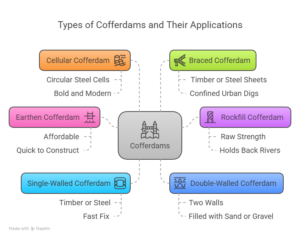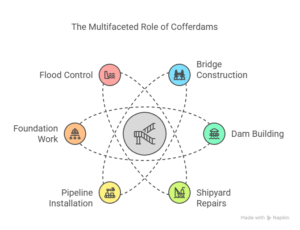Table of Contents
Introduction
Imagine you’re standing at the edge of a construction site, water lapping at the boundaries. Workers build fearlessly below the surface. How do they conquer the chaos of nature to create marvels like bridges or dams? That’s what we’re going to explore in this blog about cofferdams. Whether you’re just starting out or looking to boost your career, you’ll want to know the secrets of these unsung stars of construction.
Cofferdams make the impossible possible. They tame rivers and seas for projects worth billions globally. From towering skyscrapers to vital infrastructure, they’re the backbone of progress. That’s what we’ll be looking at in this blog: what a cofferdam is, its different types and, just as importantly, its game-changing uses.
Get hands-on with our Quantity Surveyor course—sign up for a free demo!
What Is a Cofferdam?
1: What is the main purpose of a Bill of Quantities (BoQ)?
Let’s start with the basics. A cofferdam is a temporary enclosure built to hold back water. That gives construction crews a dry space to work in, even in the trickiest spots. Picture a river roaring past, yet inside a cofferdam, workers can lay foundations as if on solid land. That’s the power of a cofferdam.
At its core, a cofferdam pumps out water from an enclosed area, often near rivers, lakes or oceans. It creates a safe zone for building. Once the job’s done, the cofferdam disappears, leaving behind a legacy of bridges, piers or dams. That versatility and cost-effectiveness are what makes cofferdams so attractive.
Mastering cofferdam construction opens doors to engineering brilliance. Want to lead such projects? The Entri Quantity Surveyor Course can give you the skills to manage them, blending theory with real-world experience. We’ll explore the types of cofferdams that make them so irresistible next.
Master Quantity Surveying – Build a Rewarding Career Today!
Gain in-demand skills in cost estimation, project budgeting, and contract management with our Quantity Surveying Course. Learn from industry experts and boost your career in construction and infrastructure. Enroll now and take the first step toward success!
Know MoreTypes of Cofferdams
Cofferdams come in different shapes and sizes. Each type is tailored to conquer specific challenges. We’ll break down the main types and show you why cofferdam types and uses deserve your attention.
- Earthen Cofferdam:
- Built from soil and clay, this type thrives in shallow, calm waters.
- It’s affordable and quick to construct, perfect for budget-savvy projects dreaming big in 2025.
- Rockfill Cofferdam:
- Packed with rocks and stones, it stands tough in deeper, faster currents.
- Imagine it holding back a raging river; that’s raw strength you can bank on.
- Single-Walled Cofferdam:
- A single layer of timber or steel sheets, ideal for narrow, shallow sites.
- Simple yet effective, it’s your go-to for tight spaces needing a fast fix.
- Double-Walled Cofferdam:
- Two walls braced together, filled with sand or gravel, built for deeper waters.
- It’s the heavyweight champ, offering stability that makes engineers cheer.
- Cellular Cofferdam:
- Circular steel cells filled with soil or rock, excelling in wide, deep rivers.
- Picture a fortress of rings; it’s bold, modern, and screams 2025 innovation.
- Braced Cofferdam:
- Timber or steel sheets supported by braces, shining in confined urban digs.
- Compact and sturdy, it’s the urban warrior you’d bet on every time.
Each type dazzles in its own way. A 2024 construction journal noted cellular cofferdams cut project timelines by 15% in deep-water builds, a stat to make your heart race. Want to oversee such wonders? The Entri Quantity Surveyor Course dives into these designs, turning you into a site-savvy pro. Ready to see how they’re used? Let’s dive deeper!
Uses of Cofferdams
Uses of cofferdams are where the real action happens. And that action is taking place across industries, in ways that will keep you interested. Cofferdams aren’t just a pretty face. They’re the backbone behind some of the most impressive projects out there. Let’s take a look at just a few examples of where they shine.
Bridge Construction:
- Ever wonder how bridge piers rise from rivers? Cofferdams create dry beds for concrete pouring.
- They’re the unsung heroes behind every crossing you admire, a thrill worth mastering.
Dam Building:
- Dams tame wild waters, and cofferdams divert rivers during construction.
- Picture redirecting a torrent; it’s power you can wield with the right skills.
Shipyard Repairs:
- Fixing ships below the waterline needs dry docks; cofferdams step in for quick patches.
- It’s fast, efficient, and a nod to 2025’s on-the-fly engineering needs.
Pipeline Installation:
- Laying pipes underwater? Cofferdams keep the site dry for seamless welds.
- Precision meets practicality, a combo that hooks any project lover.
Foundation Work:
- Skyscrapers near shores rely on cofferdams for rock-solid bases.
- They turn soggy ground into a builder’s dream, sparking awe every time.
Flood Control:
- Temporary cofferdams block water during repairs or emergencies.
- Saving communities from chaos? That’s a purpose to rally behind.
These uses aren’t small potatoes. Global infrastructure spending hit $9 trillion in 2025, per industry forecasts, with cofferdams playing a starring role. For healthcare pros eyeing quantity surveying or anyone chasing construction glory, the Entri Quantity Surveyor Course offers the know-how to lead these feats. Convinced yet? Let’s wrap this up with a bang.
Start Your Journey To A Prosperous Career ! Study Quantity Surveying With Professional Mentors!
Final Thought
What you learn in that course about cofferdams and more will help you see construction in a whole new light. You’ll be inspired to act. And with $9 trillion fueling global builds in 2025, cofferdams are hotter than ever.
That’s a trend worth getting in on. So, start by exploring a cofferdam type today. Dream up a project tomorrow. Before long, you’ll see construction differently. Maybe even lead it.
Your career deserves that spark. You gain insight, excitement, a future. The Entri Quantity Surveyor Course is waiting. It turns cofferdam curiosity into mastery. Step up, dive in, and build your path to greatness.
Master Quantity Surveying – Build a Rewarding Career Today!
Gain in-demand skills in cost estimation, project budgeting, and contract management with our Quantity Surveying Course. Learn from industry experts and boost your career in construction and infrastructure. Enroll now and take the first step toward success!
Know MoreFrequently Asked Questions
What exactly is a cofferdam in construction?
A cofferdam is a temporary enclosure built to keep water out, creating a dry work area for projects. It’s your key to building in rivers or seas effortlessly.
Why are cofferdams important for building projects?
Cofferdams enable safe, dry construction in wet environments, supporting bridges and dams. They’re essential for tackling nature’s challenges with confidence.
What are the main types of cofferdams used today?
Key types include earthen, rockfill, and cellular cofferdams, each suited to specific water conditions. Knowing them boosts your construction game significantly.
How does a cellular cofferdam work in deep water?
Circular steel cells filled with soil or rock form a cellular cofferdam, holding back deep currents. It’s a modern marvel you can master with skills from Entri Quantity Surveyor Course.
Can cofferdams be used for flood control?
Yes, temporary cofferdams block water during emergencies or repairs, protecting communities. They’re a quick fix that proves their versatility every time.
What’s the difference between single and double-walled cofferdams?
Single-walled cofferdams use one layer for shallow sites, while double-walled ones, filled with material, tackle deeper waters. Both shine when you understand their strengths.
How do cofferdams help in bridge construction?
Cofferdams create dry zones for pouring bridge pier foundations in rivers or lakes. They turn impossible builds into triumphs you can lead.
Are cofferdams expensive to build for small projects?
Earthen or single-walled cofferdams offer cost-effective options for smaller sites. Learning to choose wisely with Entri Quantity Surveyor Course saves money and time.
What materials are commonly used in cofferdam construction?
Soil, rocks, timber, and steel sheets build cofferdams, depending on the type and site. This variety makes them adaptable and exciting to explore.
How can I learn more about cofferdam applications?
Study their types and uses through resources like this blog or hands-on training. The Entri Quantity Surveyor Course offers the skills to apply them professionally.


























